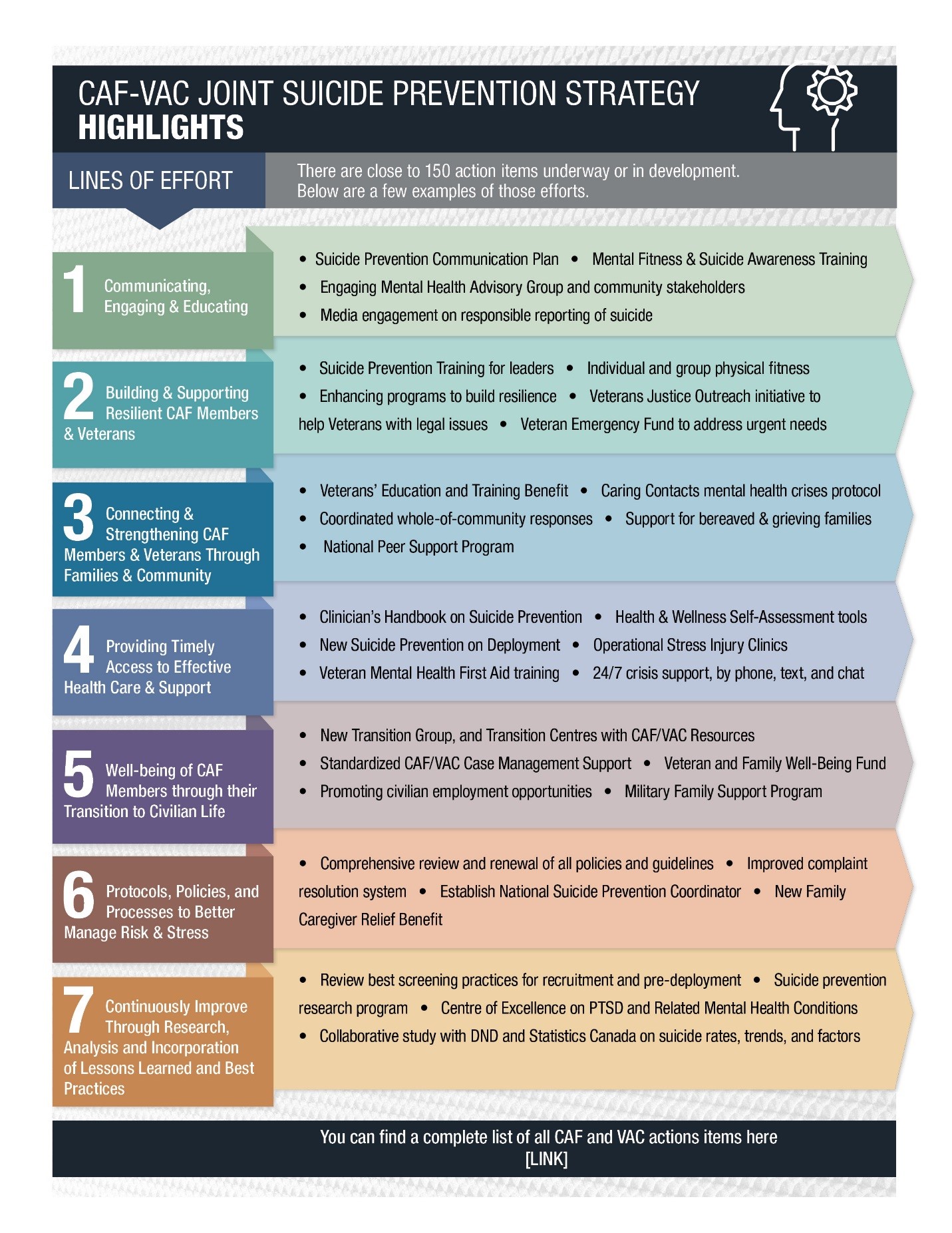Suicide in the Canadian Armed Forces and veteran communities
Joint Suicide Prevention Strategy
Canadian Armed Forces and Veterans Affairs Canada
The CAF publishes an annual Report on Suicide Mortality in the Canadian Armed Forces, with the most recent report published in November 2016. The report takes a long-term view of all suicides by CAF personnel, analyses trends and demographics, and compares the CAF suicide rate with that of the Canadian population. The data is drawn from the Directorate of Force Health Protection Surveillance database. Since 2010, a Medical Professional Technical Suicide Review (MPTSR) has been ordered by the Deputy Surgeon General immediately following the confirmation of every suicide, and is conducted by a two-person team typically composed of a General Duty Medical Officer (a military family physician) and a military psychiatrist or other mental health specialist. These clinicians interview family, friends, colleagues, the chain of command, and health care providers in order to gain an understanding of the circumstances surrounding the death. Lessons learned can be used to improve suicide prevention programs or other health-services programs. To date, such reviews have provided greater insight into suicide in the CAF and into how to enhance mental health care and services.
A study by Statistics Canada compared the reported suicide rate in serving and released CAF members (Veterans) who enrolled in service from 1972 to 2006. The study found that male Veterans were more likely to die by suicide than similarly aged males in the general population, averaged over the 35-year study period. In general, female Veterans were far less likely to die by suicide than males and were not more likely to die by suicide than women in the general population. Factors associated with suicide in the Veterans in this study were male sex, age 30 or older, non-commissioned member rank, less than 10 years of service, medical release and involuntary release. Working with Statistics Canada and the CAF, VAC will report on suicide rates in CAF Veterans beginning in December 2017.
To better understand the scale of the issue for Veterans, we can look to suicidal thinking as a key indicator, because it identifies people who might be on a pathway to attempt suicide. The Life After Service Surveys (LASS) – major surveys conducted every three years, since 2010 – provide a clear picture of the extent of suicidal ideation and attempts, as well as the factors associated with these behaviours in CAF Veterans released from service since 1998. In Regular Force Veterans in 2010, the prevalence of past-year suicidal ideation was 5.8% and past-year attempts was 1.0%. By comparison, the prevalence of suicidal ideation in Veterans participating in VAC programs was higher at 10%. This finding is not surprising because the great majority of Veterans participating in VAC programs have chronic physical or mental health conditions, and it is well established that people with health problems have higher rates of suicidality.
The numbers provide us with information and understanding. However we have been called to action by the real people, families and communities behind the statistics. These are our loved ones, our comrades, and our family members, and the entire CAF and VAC communities are moved to continue to do everything possible to lower risks and prevent suicide. We cannot prevent every tragedy, but leadership throughout our organizations is united in believing that even one suicide is too many.

CAF-VAC Joint Suicide Prevention Strategy - Highlights
-
- Lines of effort
- There are over 150 actions underway or in development. Below are a few examples of those efforts
- Communicating, Engaging & Educating
- Suicide Prevention Communication Plan
- Mental Fitness & Suicide Awareness Training
- Engaging Mental Health Advisory Group and community stakeholders
- Media engagement on responsible reporting of suicide
- Building & Supporting Resilient CAF Members & Veterans
- Suicide Prevention Training for leaders
- Individual and group physical fitness
- Enhancing programs to build resilience
- Veterans Justice Outreach initiative to help Veterans with legal issues
- Veterans Emergency Fund to address urgent needs
- Providing Timely Access to Effective Health Care & Support
- Clinician's Handbook on Suicide Prevention
- Health & Wellness Self-Assessment tools
- New Suicide Prevention on Deployment
- Operational Stress Injury Clinics
- Veteran Mental Health First Aid training
- 24/7 crisis support, by phone, text and chat
- Promoting Well-being of CAF Members through their Transition to Civilian Life
- New Transition Group, and Transition Centres with CAF/VAC Resources
- Standardized CAF/VAC Case Management Support
- Veteran and Family Well-Being Fund
- Promoting civilian employment opportunities
- Military Family Support Program
- Aligning Protocols, Policies, and Processes to Better Manage Risk & Stress
- Comprehensive review and renewal of all policies and guidelines
- Improved complaint resolution system
- Establish National Suicide Prevention Coordinator
- New Family Caregiver Relief Benefit
- Continuously Improve Through Research, Analysis and Incorporation of Lessons Learned and Best Practices
- Review best screening practices for recruitment and pre-deployment
- Suicide prevention research program
- Centre of Excellence on PTSD and Related Mental Health Conditions
- Collaborative study with DND and Statistics Canada on suicide rates, trends, and factors.
Joint Suicide Prevention Strategy
Canadian Armed Forces and Veterans Affairs Canada